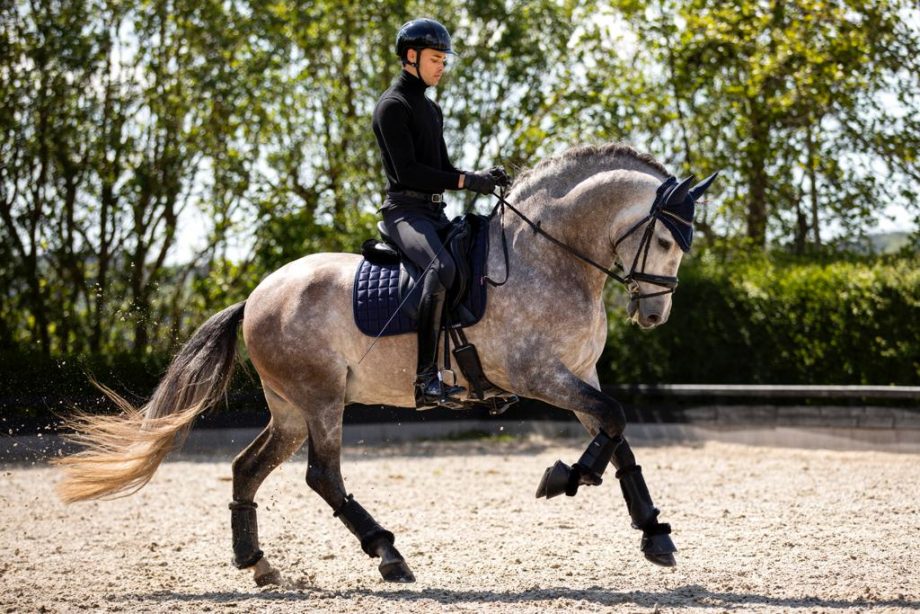In the first of a series looking at how to market yourself as a rider, Stephanie Bateman delves into the world of social media and discovers the dos and don’ts of promoting yourself online
Being a professional rider is no longer just about producing and competing horses, it’s about running a business, and effective social media is key to this.
“Social media gives you the opportunity to put yourself in front of the world, including prospective sponsors and owners,” says Ashley Rossiter, managing director of PR and social media marketing agency Mirror Me PR.
“It gives you the chance to be seen by a huge audience and highlight your progress, horses, achievements and professionalism.”
{"content":"PHA+UmFpc2luZyBhd2FyZW5lc3Mgb2YgeW91ciBvd24gcGVyc29uYWwgYnJhbmQsIGNvbm5lY3Rpbmcgd2l0aCB0aGUgYXVkaWVuY2UgYW5kIHJhaXNpbmcgdGhlIHByb2ZpbGUgb2YgdGhlIHNwb3J0IGFyZSBhbHNvIGFjaGlldmVkIHRocm91Z2ggc29jaWFsIG1lZGlhLjwvcD4KPHA+4oCcSXTigJlzIHlvdXIgc2hvcCB3aW5kb3cgdG8gdGhlIHdvcmxkLOKAnSBvZmZlcnMgU2FyYWggU2tpbGxpbiwgZm91bmRlciBvZiBtYXJrZXRpbmcgYW5kIGNvbW1lcmNpYWwgYWdlbmN5IEVxdWlDb25zdWx0aW5nLiDigJxJdOKAmXMgd2hlcmUgcGVvcGxlIGdvIHRvIGZvciBldmVyeXRoaW5nLCBzbyBpdOKAmXMga2V5IGZvciBldmVyeW9uZSB0byBoYXZlIGEgcHJlc2VuY2Uu4oCdPC9wPgo8cD48ZGl2IGNsYXNzPSJhZC1jb250YWluZXIgYWQtY29udGFpbmVyLS1tb2JpbGUiPjxkaXYgaWQ9InBvc3QtaW5saW5lLTIiIGNsYXNzPSJpcGMtYWR2ZXJ0Ij48L2Rpdj48L2Rpdj48c2VjdGlvbiBpZD0iZW1iZWRfY29kZS0zMSIgY2xhc3M9ImhpZGRlbi1tZCBoaWRkZW4tbGcgcy1jb250YWluZXIgc3RpY2t5LWFuY2hvciBoaWRlLXdpZGdldC10aXRsZSB3aWRnZXRfZW1iZWRfY29kZSBwcmVtaXVtX2lubGluZV8yIj48c2VjdGlvbiBjbGFzcz0icy1jb250YWluZXIgbGlzdGluZy0tc2luZ2xlIGxpc3RpbmctLXNpbmdsZS1zaGFyZXRocm91Z2ggaW1hZ2UtYXNwZWN0LWxhbmRzY2FwZSBkZWZhdWx0IHNoYXJldGhyb3VnaC1hZCBzaGFyZXRocm91Z2gtYWQtaGlkZGVuIj4NCiAgPGRpdiBjbGFzcz0icy1jb250YWluZXJfX2lubmVyIj4NCiAgICA8dWw+DQogICAgICA8bGkgaWQ9Im5hdGl2ZS1jb250ZW50LW1vYmlsZSIgY2xhc3M9Imxpc3RpbmctaXRlbSI+DQogICAgICA8L2xpPg0KICAgIDwvdWw+DQogIDwvZGl2Pg0KPC9zZWN0aW9uPjwvc2VjdGlvbj48L3A+CjxwPkl04oCZcyBhbHNvIGEgZ3JlYXQgd2F5IHRvIHByb21vdGUgc3BvbnNvcnMgYW5kIGJyYW5kcy48L3A+CjxwPuKAnFRoZSBmaXJzdCB0aGluZyBicmFuZHMgbG9vayBhdCB3aGVuIHNlYXJjaGluZyBmb3IgcmlkZXJzIHRvIHNwb25zb3IgaXMgdGhlaXIgcHJlc2VuY2Ugb24gc29jaWFsIG1lZGlhLCBldmVuIGlmIHlvdeKAmXJlIHJpZGluZyBhdCB0b3AgbGV2ZWws4oCdIHNheXMgRGVicmEgSGFyZ3JhdmUgb2YgdGhlIGVwb255bW91cyBQUiBjb21wYW55LiBCdXQgU2FyYWggY291bnRlcnM6IOKAnEFzIG11Y2ggYXMgYnJhbmRzIHdpbGwsIGFuZCBzaG91bGQsIGxvb2sgYXQgYSBzb2NpYWwgZm9sbG93aW5nLCBpdCBpc27igJl0IHRoZSBiZSBhbGwgYW5kIGVuZCBhbGwgYW5kIGl0IGNvdWxkIGJlIHF1aXRlIHNob3J0LXNpZ2h0ZWQgb2YgYnJhbmRzIHRvIHVzZSBhIHJpZGVy4oCZcyBzb2NpYWwgcHJlc2VuY2UgYXMgdGhlIG1haW4gaW5kaWNhdG9yIGFzIHRvIHdoZXRoZXIgdGhleSBhcmUgdGhlIG9uZXMgdG8gc3BvbnNvci4gSW5mbHVlbmNpbmcgaXMgb2Z0ZW4gZG9uZSB3ZWxsIG9uIGEgd29yZCBvZiBtb3V0aCBvciBwZXJzb25hbCBsZXZlbC4gUmlkZXJzIHNob3VsZG7igJl0IHB1dCB0b28gbXVjaCBwcmVzc3VyZSBvbiB0aGVtc2VsdmVzIHRvIHBlcmZvcm0gb24gc29jaWFsLCBvdmVyIHBlcmZvcm1pbmcgb24gdGhlIGZpZWxkLuKAnTwvcD4KPGgzPkRJWSBvciBnZXQgdGhlIGluIHRoZSBwcm9zPzwvaDM+CjxwPk1hbmFnaW5nIHNvY2lhbCBtZWRpYSBhY2NvdW50cyBpcyB0aW1lLWNvbnN1bWluZywgc28gd2hhdCBhcmUgdGhlIG9wdGlvbnM\/PC9wPgo8ZGl2IGNsYXNzPSJhZC1jb250YWluZXIgYWQtY29udGFpbmVyLS1tb2JpbGUiPjxkaXYgaWQ9InBvc3QtaW5saW5lLTMiIGNsYXNzPSJpcGMtYWR2ZXJ0Ij48L2Rpdj48L2Rpdj4KPHA+4oCcRG9pbmcgaXQgeW91cnNlbGYsIHlvdSBoYXZlIGNvbXBsZXRlIGNvbnRyb2wgb3ZlciB3aGF0IGdvZXMgb3V0IGJ1dCB5b3UgaGF2ZSB0byBmaW5kIHRoZSB0aW1lLOKAnSBzYXlzIFNhcmFoLiDigJxIYW5kaW5nIGl0IG92ZXIgY29tcGxldGVseSBtZWFucyB5b3UgY2FuIGZvY3VzIG9uIHlvdXIgam9iLCBidXQgaXQgY2FuIHJlbW92ZSB0aGUgcGVyc29uYWwgZWxlbWVudC7igJ08L3A+CjxwPkEgY29tYmluZWQgYXBwcm9hY2ggY2FuIGJlIHRoZSBhbnN3ZXIuPC9wPgo8ZGl2IGNsYXNzPSJhZC1jb250YWluZXIgYWQtY29udGFpbmVyLS1tb2JpbGUiPjxkaXYgaWQ9InBvc3QtaW5saW5lLTQiIGNsYXNzPSJpcGMtYWR2ZXJ0Ij48L2Rpdj48L2Rpdj4KPHA+4oCcT25lIHdheSB0aGF0IHdvcmtzIHdlbGwgaXMgdG8gY29sbGF0ZSB0aGUgbWF0ZXJpYWwgc3VjaCBhcyB2aWRlb3MgYW5kIHBob3RvcyB5b3Vyc2VsZiwgYW5kIHRoZW4gc2VuZCB0aGVtIHRvIGEgUFIgd2hvIHdpbGwgc2NoZWR1bGUgcG9zdHMgdG8gZ28gb3V0IGFjcm9zcyB0aGUgZGlmZmVyZW50IHBsYXRmb3JtcyB0aHJvdWdob3V0IHRoZSB3ZWVrLOKAnSBzYXlzIFNhcmFoLjwvcD4KPHA+QW5vdGhlciBvcHRpb24gaXMgdG8gYXNrIGZvciBoZWxwIHdpdGggY2VydGFpbiBhc3BlY3RzIHN1Y2ggYXMgcmVzcG9uZGluZyB0byBmb2xsb3dlcnMuIOKAnFRoYXQgY2FuIHRha2UgdGhlIHByZXNzdXJlIG9mZizigJ0gYWRkcyBTYXJhaC48L3A+CjxkaXYgY2xhc3M9ImFkLWNvbnRhaW5lciBhZC1jb250YWluZXItLW1vYmlsZSI+PGRpdiBpZD0icG9zdC1pbmxpbmUtNSIgY2xhc3M9ImlwYy1hZHZlcnQiPjwvZGl2PjwvZGl2Pgo8cD5XaGF0IGRvZXMgaXQgY29zdCB0byBwYXkgYSBQUiBmb3IgdGhpcz88L3A+CjxwPuKAnEkgY2hhcmdlIGZyb20gwqMyMDAgcGx1cyBWQVQgcGVyIG1vbnRoLCBidXQgdGhhdCBpcyBhbHNvIFBSLCBzcG9uc29yc2hpcCBhbmQ8YnIgLz4KY29tbXVuaWNhdGlvbnMgbWFuYWdlbWVudCzigJ0gdGVsbHMgU2FyYWguIOKAnFNvbWUgcmlkZXJz4oCZIGluaXRpYWwgcmVzcG9uc2UgaXMgdGhhdCB0aGV5IGNhbuKAmXQgYWZmb3JkIGl0LCBidXQgdGhhdCBlcXVhdGVzIHRvIHRoZWlyIGVhcm5pbmdzIGZyb20gZm91ciBsZXNzb25zIGEgbW9udGguIElzIHBheWluZyBzb21lb25lIGVsc2UgbW9yZSBjb3N0LWVmZmVjdGl2ZT\/igJ08L3A+CjxwPklmIHlvdeKAmXJlIGFmdGVyIGFkdmljZSBvbiBob3cgdG8gZG8gaXQgcHJvcGVybHksIHRoZXJlIGFyZSBvcHRpb25zIHRoYXQgY291bGQgaGVscC48L3A+CjxwPuKAnFdlIHNldCB1cCBQcm8gUmlkZXIgQWNhZGVteSBmb3IgcmlkZXJzIHdobyBkb27igJl0IGhhdmUgYSBiaWcgYnVkZ2V0LCB0byBlZHVjYXRlIHRoZW0gYW5kIGdpdmUgdGhlbSB0aGUgdG9vbHMgaW4gc2VsZi1wcm9tb3Rpb24s4oCdIHNheXMgRGVicmEuIOKAnFRoZXJlIGFyZSB0aHJlZSBwYWNrYWdlcyBhdCBzZXQgcHJpY2VzLiBTb21lIHJpZGVycyBlbmpveSBkb2luZyBpdCB0aGVtc2VsdmVzIGJ1dCBsYWNrIHRoZSBrbm93bGVkZ2Uu4oCdPC9wPgo8aDM+V2hpY2ggcGxhdGZvcm0\/PC9oMz4KPHA+VGhlIG1vc3QgcG9wdWxhciBzb2NpYWwgbWVkaWEgcGxhdGZvcm1zIGFyZSBUd2l0dGVyLCBGYWNlYm9vaywgSW5zdGFncmFtLCBUaWtUb2sgYW5kIExpbmtlZEluLjwvcD4KPHA+4oCcSWYgeW91IG9ubHkgaGF2ZSB0aW1lIHRvIG1hbmFnZSBvbmUsIHRoZW4gb25seSBoYXZlIG9uZSzigJ0gc2F5cyBBc2hsZXkuIOKAnElkZWFsbHksIHR3byBvciBtb3JlIGdpdmUgeW91IG1vcmUgZGlzY292ZXJ5IG9wcG9ydHVuaXRpZXMsIGJ1dCB5b3UgbmVlZCB0byBrZWVwIHRoZW0gdXAgdG8gZGF0ZS7igJ08L3A+CjxwPkVhY2ggcGxhdGZvcm0gaGFzIGl0cyBvd24gYXVkaWVuY2UsIHBlcnNvbmFsaXR5IGFuZCBkZW1vZ3JhcGhpYy48L3A+CjxwPuKAnEZhY2Vib29rIGlzIGdvb2QgZm9yIGJ1c2luZXNzIGFuZCBhY2hpZXZpbmcgYSB3aWRlIHJlYWNoIHVzaW5nIGxvbmdlciB2aWRlb3MgYW5kIHBvc3RzLOKAnSBzYXlzIFNhcmFoLiDigJxUd2l0dGVyIGlzIGdvb2QgZm9yIG5ld3MgYW5kIHNob3J0LCBzaGFycCBzbmlwcGV0czsgSW5zdGFncmFtIGlzIGdyZWF0IGZvciBwb3N0aW5nIHNob3J0IHZpZGVvcyBhbmQgcGhvdG9zLCBhbmQgVGlrVG9rIGlzIGZ1biBidXQgdGFrZXMgbW9yZSBlZmZvcnQuIExpbmtlZEluIGlzIGdyZWF0IGZvciBlbmdhZ2luZyB3aXRoIHNwb25zb3JzIGFuZCBvd25lcnMgY29tbWVyY2lhbGx5LuKAnTwvcD4KPHA+UG9zdGluZyB0aGUgc2FtZSBjb250ZW50IGFjcm9zcyBwbGF0Zm9ybXMgaXMgYWNjZXB0YWJsZSBhbmQgdGltZS1lZmZlY3RpdmUuPC9wPgo8cD7igJxJZiBzb21ldGhpbmcgaGFwcGVucyBpbnN0YW50bHkgYW5kIG9yZ2FuaWNhbGx5LCBwb3N0IGl0IGFzIGEgc3Rvcnks4oCdIGFkdmlzZXMgRGVicmEsIHJlZmVycmluZyB0byB0aGUgZmVhdHVyZSBmb3IgdGVtcG9yYXJ5IGNvbnRlbnQgd2hpY2ggaXMgcGFydGljdWxhcmx5IHBvcHVsYXIgb24gSW5zdGFncmFtLjwvcD4KPHA+4oCcRG9u4oCZdCBmb3JnZXQgeW91IGFsc28gbmVlZCBjb25zaXN0ZW5jeSBvbiB5b3VyIGdyaWQgW3RoZSBwb3N0ZWQgcGljdHVyZXMgeW91IHNlZTxiciAvPgpieSBjbGlja2luZyBvbiBhIHByb2ZpbGUgb24gSW5zdGFncmFtXSwgc28gaXQgbmVlZHMgdG8gYmUgYWNyb3NzIGJvdGggYW5kIG1ha2Ugc3VyZSB5b3UgdGFnIHNwb25zb3JzIGFuZCB1c2UgYXBwcm9wcmlhdGUgaGFzaHRhZ3Mu4oCdPC9wPgo8cD5XaGVuIGl0IGNvbWVzIHRvIGNvbnRlbnQsIGEgZ29vZCBtaXggb2YgdmlkZW8gYW5kIGltYWdlcyBpcyBhZHZpc2FibGUuPC9wPgo8cD7igJxQZW9wbGUgbG92ZSB0byBzZWUgYmVoaW5kIHRoZSBzY2VuZXMsIHdoaWNoIGlzIGdvb2QgZm9yIHByb2R1Y3QgcGxhY2VtZW50LCB0b28s4oCdIHNheXMgRGVicmEuIOKAnFRoZXkgYWxzbyBsaWtlIHJvdW5kLXVwcyBvZiBzaG93cywgbmV3cyB1cGRhdGVzIGFuZCBpbnRyb2R1Y2luZyB0aGUgaG9yc2VzIGFuZCB0aGVpciBwZXJzb25hbGl0aWVzLiBIdW1vdXIgd29ya3Mgd2VsbCBidXQga2VlcCBpdCBzZW5zaWJsZS7igJ08L3A+CjxwPklmIHlvdSBtZW50aW9uIHNwb25zb3JzIGFuZCB0aGVpciBwcm9kdWN0cywgY2hlY2sgb3V0IHRoZSBBZHZlcnRpc2luZyBTdGFuZGFyZHMgQWdlbmN5IGFuZCBDb21wZXRpdGlvbiBhbmQgTWFya2V0cyBBdXRob3JpdHkgZ3VpZGVsaW5lcyBmb3IgaW5mbHVlbmNlcnMsIGFuZCBiZSBhd2FyZSBvZiB3aGVuIHlvdSBuZWVkIHRvIHVzZSAjYWQuPC9wPgo8aDM+V2hlbiB0aGluZ3MgZ28gd3Jvbmc8L2gzPgo8cD5MaWZlIHdpdGggaG9yc2VzIGlzIG5ldmVyIHBlcmZlY3QuIOKAnFNoYXJpbmcgdGhlIGhpZ2hzIGFuZCBsb3dzIGlzbuKAmXQgYSBiYWQgdGhpbmcgYnV0IGdldHRpbmcgdGhlIGJhbGFuY2UgcmlnaHQgd2hlbiBzaGFyaW5nIG5ld3MgbmVlZHMgdGhvdWdodCzigJ0gYWR2aXNlcyBBc2hsZXkuPC9wPgo8cD5CZSBob25lc3QgYW5kIHRyYW5zcGFyZW50LjwvcD4KPHA+4oCcRG9u4oCZdCBiZSBhZnJhaWQgdG8gcHVsbCB0b2dldGhlciBhIHZpZGVvIHRvIGV4cGxhaW4gd2hhdCB3ZW50IHdyb25nLOKAnSBzYXlzIFNhcmFoLjwvcD4KPHA+V2hlbiBpdCBjb21lcyB0byByZXBvcnRpbmcgcGVyaGFwcyB0aGUgd29yc3QgbmV3cyDigJMgdGhlIGRlYXRoIG9mIGEgaG9yc2UgYXQgYW4gZXZlbnQg4oCTIG1vc3QgZ292ZXJuaW5nIGJvZGllcyBoYXZlIGd1aWRlbGluZXMgaW4gcGxhY2Ugd2hpY2ggeW91IHNob3VsZCBiZWFyIGluIG1pbmQuPC9wPgo8cD7igJxUaGUga2V5IHdpdGggcG9zdGluZyBhbnl0aGluZyBpcyB0byB0aGluayBiZWZvcmUgeW91IHBvc3Qs4oCdIHNheXMgRGVicmEuIOKAnERvbuKAmXQgZ2V0IGludG8gcm93cyB3aXRoIHBlb3BsZSDigJMgc2xlZXAgb24gaXQgYmVmb3JlIHlvdSBjb21tZW50LCBvciBkb27igJl0IGNvbW1lbnQu4oCdPC9wPgo8cD5Eb3VibGUgY2hlY2sgcGhvdG9zIGFuZCB2aWRlb3MsIHRvby48L3A+CjxwPuKAnERvbuKAmXQgcG9zdCBhbnl0aGluZyB0aGF0IGlzIGdvaW5nIHRvIGJlIGNsYXNzZWQgYXMgYmFkIHdlbGZhcmUs4oCdIHNheXMgU2FyYWguIOKAnElmIHlvdeKAmXZlIHBvc3RlZCBzb21ldGhpbmcgeW91IHNob3VsZG7igJl0LCByZW1vdmUgdGhlIHBvc3QgYW5kIHJlc3BvbmQgYXBvbG9naXNpbmcgYW5kIGV4cGxhaW5pbmcgd2hhdCBoYXBwZW5lZC4gRG9u4oCZdCBnZXQgY2F1Z2h0IHVwIHdpdGggcmVhZGluZyBuZWdhdGl2ZSBjb21tZW50cy7igJ08L3A+CjxwPklmIHRoaW5ncyBnZXQgcmVhbGx5IG5hc3R5LCBpdCBtaWdodCBiZSB3b3J0aCBjYWxsaW5nIGluIGEgcHJvZmVzc2lvbmFsIHRvIGhlbHAgeW91LjwvcD4KPHA+4oCcQSBwcm9mZXNzaW9uYWwgUFIgcGVyc29uIHdpbGwgaGVscCB5b3UgZGVhbCB3aXRoIHJlcXVlc3RzIGZyb20gdGhlIHByZXNzIGFuZCBwdXQgdG9nZXRoZXIgYSBzdGF0ZW1lbnQgZm9yIHlvdSzigJ0gc2F5cyBEZWJyYS48L3A+CjxoMz5Ib3cgdGhlIHJpZGVycyBkbyBpdDogZml2ZS1zdGFyIHdpbm5lciBMYXVyYSBDb2xsZXR0IChwaWN0dXJlZCB0b3ApPC9oMz4KPHA+4oCcSSBzZWUgc29jaWFsIG1lZGlhIGFzIHBhcnQgb2YgdGhlIHdvcmxkIHdlIGxpdmUgaW4gYW5kIHRyeSB0byB1c2UgaXQgdG8gbXkgYWR2YW50YWdlIGFuZCB0byBwcm9tb3RlIHNwb25zb3JzLiBJIHByZWZlciB0byB3cml0ZSBpdCBteXNlbGYgYXMgcGVvcGxlIGZlZWwgY2xvc2VyIHRvIHlvdS48L3A+CjxwPuKAnEkgcG9zdCBpbXBvcnRhbnQgdGhpbmdzIG9uIEZhY2Vib29rIGFuZCBUd2l0dGVyIGJ1dCBldmVyeWRheSBzdHVmZiBnb2VzIG9uIEluc3RhZ3JhbS4gU29tZSBkYXlzIEkgcG9zdCBsb3RzIGFuZCBvdGhlciBkYXlzIG5vdGhpbmcuPC9wPgo8cD7igJxJIG5kIHBlb3BsZSBsaWtlIHRoZSBiZWhpbmQtdGhlLXNjZW5lcyBjb250ZW50IGJlY2F1c2UgdGhhdOKAmXMgd2hhdCB0aGV5IGRvbuKAmXQgZ2V0IHRvIHNlZS4gSSBwb3N0IHdoZW4gdGhpbmdzIGdvIHdyb25nIGFzIEkgdGhpbmsgaXTigJlzIGltcG9ydGFudCBmb3IgcGVvcGxlIHRvIHVuZGVyc3RhbmQgZXZlcnlvbmUgZ29lcyB0aHJvdWdoIHRoZSBiYWQgdGltZXMuIEV2ZXJ5b25lIGlzIGVudGl0bGVkIHRvIHRoZWlyIG93biBvcGluaW9uLCBidXQgSSBkb27igJl0IHJlcGx5IHRvIG5lZ2F0aXZlIGNvbW1lbnRzIGJlY2F1c2UgSSB0aGluayB5b3UganVzdCBmdWVsIHBlb3BsZSBieSBkb2luZyB0aGF0LuKAnTwvcD4KPGgzPkhvdyB0aGUgcmlkZXJzIGRvIGl0OiBPbHltcGljIGV2ZW50ZXIgTWFyeSBLaW5nPC9oMz4KPHA+PGltZyBmZXRjaHByaW9yaXR5PSJoaWdoIiBkZWNvZGluZz0iYXN5bmMiIGNsYXNzPSJsYXp5bG9hZCBibHVyLXVwIGFsaWdubm9uZSBzaXplLWZ1bGwgd3AtaW1hZ2UtNzIwNzMzIiBkYXRhLXByb2Nlc3NlZCBzcmM9Imh0dHBzOi8va2V5YXNzZXRzLnRpbWVpbmN1ay5uZXQvaW5zcGlyZXdwL2xpdmUvd3AtY29udGVudC91cGxvYWRzL3NpdGVzLzE0LzIwMTcvMDMvbmV3LWhoLXBsYWNlaG9sZGVyLTIwMHgyMDAucG5nIiBkYXRhLXNyYz0iaHR0cHM6Ly9rZXlhc3NldHMudGltZWluY3VrLm5ldC9pbnNwaXJld3AvbGl2ZS93cC1jb250ZW50L3VwbG9hZHMvc2l0ZXMvMTQvMjAyMC8wNy9Ib3JzZU5vODY1X0JpY3Rvbl8yMFBOXzc0MzMwXzQwMjQ4MDQ2MV83MTE1NzIzNTIuanBnIiBhbHQ9IiZsdDtwJmd0O01hcnkgS2luZyByaWRpbmcgS0lORyBST0JFUlQgSUkgaW4gT0kgU2VjdGlvbiBRIGR1cmluZyBCaWN0b24gQXJlbmEgKDIpIEhvcnNlIFRyaWFscyBpbiBFYXN0IEJ1ZGxlaWdoIG5lYXIgRXhtb3V0aCBpbiBEZXZvbiBpbiB0aGUgVUsgb24gdGhlIDI2dGggSnVseSAyMDIwJmx0Oy9wJmd0OyIgd2lkdGg9IjE0MDAiIGhlaWdodD0iNzg4IiBkYXRhLXNpemVzPSJhdXRvIiBkYXRhLXNyY3NldD0iaHR0cHM6Ly9rZXlhc3NldHMudGltZWluY3VrLm5ldC9pbnNwaXJld3AvbGl2ZS93cC1jb250ZW50L3VwbG9hZHMvc2l0ZXMvMTQvMjAyMC8wNy9Ib3JzZU5vODY1X0JpY3Rvbl8yMFBOXzc0MzMwXzQwMjQ4MDQ2MV83MTE1NzIzNTIuanBnIDE0MDB3LCBodHRwczovL2tleWFzc2V0cy50aW1laW5jdWsubmV0L2luc3BpcmV3cC9saXZlL3dwLWNvbnRlbnQvdXBsb2Fkcy9zaXRlcy8xNC8yMDIwLzA3L0hvcnNlTm84NjVfQmljdG9uXzIwUE5fNzQzMzBfNDAyNDgwNDYxXzcxMTU3MjM1Mi0zMDB4MTY5LmpwZyAzMDB3LCBodHRwczovL2tleWFzc2V0cy50aW1laW5jdWsubmV0L2luc3BpcmV3cC9saXZlL3dwLWNvbnRlbnQvdXBsb2Fkcy9zaXRlcy8xNC8yMDIwLzA3L0hvcnNlTm84NjVfQmljdG9uXzIwUE5fNzQzMzBfNDAyNDgwNDYxXzcxMTU3MjM1Mi02MzB4MzU1LmpwZyA2MzB3LCBodHRwczovL2tleWFzc2V0cy50aW1laW5jdWsubmV0L2luc3BpcmV3cC9saXZlL3dwLWNvbnRlbnQvdXBsb2Fkcy9zaXRlcy8xNC8yMDIwLzA3L0hvcnNlTm84NjVfQmljdG9uXzIwUE5fNzQzMzBfNDAyNDgwNDYxXzcxMTU3MjM1Mi0xMzV4NzYuanBnIDEzNXcsIGh0dHBzOi8va2V5YXNzZXRzLnRpbWVpbmN1ay5uZXQvaW5zcGlyZXdwL2xpdmUvd3AtY29udGVudC91cGxvYWRzL3NpdGVzLzE0LzIwMjAvMDcvSG9yc2VObzg2NV9CaWN0b25fMjBQTl83NDMzMF80MDI0ODA0NjFfNzExNTcyMzUyLTMyMHgxODAuanBnIDMyMHcsIGh0dHBzOi8va2V5YXNzZXRzLnRpbWVpbmN1ay5uZXQvaW5zcGlyZXdwL2xpdmUvd3AtY29udGVudC91cGxvYWRzL3NpdGVzLzE0LzIwMjAvMDcvSG9yc2VObzg2NV9CaWN0b25fMjBQTl83NDMzMF80MDI0ODA0NjFfNzExNTcyMzUyLTYyMHgzNDkuanBnIDYyMHcsIGh0dHBzOi8va2V5YXNzZXRzLnRpbWVpbmN1ay5uZXQvaW5zcGlyZXdwL2xpdmUvd3AtY29udGVudC91cGxvYWRzL3NpdGVzLzE0LzIwMjAvMDcvSG9yc2VObzg2NV9CaWN0b25fMjBQTl83NDMzMF80MDI0ODA0NjFfNzExNTcyMzUyLTkyMHg1MTguanBnIDkyMHcsIGh0dHBzOi8va2V5YXNzZXRzLnRpbWVpbmN1ay5uZXQvaW5zcGlyZXdwL2xpdmUvd3AtY29udGVudC91cGxvYWRzL3NpdGVzLzE0LzIwMjAvMDcvSG9yc2VObzg2NV9CaWN0b25fMjBQTl83NDMzMF80MDI0ODA0NjFfNzExNTcyMzUyLTEyMjB4Njg3LmpwZyAxMjIwdyIgc2l6ZXM9IihtYXgtd2lkdGg6IDE0MDBweCkgMTAwdncsIDE0MDBweCIgLz48L3A+CjxwPuKAnEkgcG9zdCBhbiB1cGRhdGUgb24gRmFjZWJvb2sgb25jZSBhIG1vbnRoIGFib3V0IHdoYXQgSeKAmXZlIGJlZW4gZG9pbmcgd2l0aCB0aGUgaG9yc2VzIGFuZCB0cnkgdG8gbWVudGlvbiBzb21lIHNwb25zb3JzIHdpdGhvdXQgaXQgc2VlbWluZyBsaWtlIGFuIGFkdmVydGlzaW5nIHBpZWNlLiBJIG5ldmVyIHBvc3QgYW55dGhpbmcgYWJvdXQgbXkgcGVyc29uYWwgbGlmZS4gSSBhbHNvIHVzZSBGYWNlYm9vayB0byBwb3N0IHNvbWV0aGluZyBmb3IgbXkgc3BvbnNvcnMgc3VjaCBhcyBzaGFyaW5nIGEgcG9zdCBmb3IgdGhlbS48L3A+CjxwPuKAnEkgaGF2ZSBhIGxveWFsIGZvbGxvd2luZywgYnV0IGRvbuKAmXQgcmVwbHkgdG8gcGVvcGxlIOKAkyBJIGp1c3QgdXNlIGl0IGFzIGEgcGxhdGZvcm0gdG8ga2VlcCBwZW9wbGUgaW5mb3JtZWQuIEnigJltIG5vdCBpbiB0aGUgbGltZWxpZ2h0IGxpa2UgSSB1c2VkIHRvIGJlLCBidXQgYSBsb3Qgb2Ygc3BvbnNvcnMgaGF2ZSBzdHVjayB3aXRoIG1lIGFuZCBhIGxvdCBvZiBpdCBpcyBiZWNhdXNlIG9mIHRoZSBiaWcgZm9sbG93aW5nIEkgaGF2ZSBvbiBGYWNlYm9vay4gSSBrbm93IEkgc2hvdWxkIHByb2JhYmx5IGJlIG9uIEluc3RhZ3JhbSB0b28gYnV0IEkgZG9u4oCZdCBoYXZlIHRoZSB0aW1lLuKAnTwvcD4KPGgzPkhvdyB0aGUgcmlkZXJzIGRvIGl0OiBzaG93anVtcGVyIEpvZSBTdG9ja2RhbGU8L2gzPgo8cD48aW1nIGRlY29kaW5nPSJhc3luYyIgY2xhc3M9Imxhenlsb2FkIGJsdXItdXAgYWxpZ25ub25lIHNpemUtZnVsbCB3cC1pbWFnZS02ODk5OTYiIGRhdGEtcHJvY2Vzc2VkIHNyYz0iaHR0cHM6Ly9rZXlhc3NldHMudGltZWluY3VrLm5ldC9pbnNwaXJld3AvbGl2ZS93cC1jb250ZW50L3VwbG9hZHMvc2l0ZXMvMTQvMjAxNy8wMy9uZXctaGgtcGxhY2Vob2xkZXItMjAweDIwMC5wbmciIGRhdGEtc3JjPSJodHRwczovL2tleWFzc2V0cy50aW1laW5jdWsubmV0L2luc3BpcmV3cC9saXZlL3dwLWNvbnRlbnQvdXBsb2Fkcy9zaXRlcy8xNC8yMDE5LzA2LzEwLUpvLVN0b2NrZGFsZS0wNy4wNS4xOTI1ODRfMjg5MjE0MjQyXzUxMzA0ODAyMi5qcGciIGFsdD0iSm9zZXBoIFN0b2NrZGFsZSBmZWF0dXJlIDA3LjA1LjE5IEpvIFN0b2NrZGFsZSB3aXRoIENhY2hhcmVsIiB3aWR0aD0iMTQwMCIgaGVpZ2h0PSI3ODgiIGRhdGEtc2l6ZXM9ImF1dG8iIGRhdGEtc3Jjc2V0PSJodHRwczovL2tleWFzc2V0cy50aW1laW5jdWsubmV0L2luc3BpcmV3cC9saXZlL3dwLWNvbnRlbnQvdXBsb2Fkcy9zaXRlcy8xNC8yMDE5LzA2LzEwLUpvLVN0b2NrZGFsZS0wNy4wNS4xOTI1ODRfMjg5MjE0MjQyXzUxMzA0ODAyMi5qcGcgMTQwMHcsIGh0dHBzOi8va2V5YXNzZXRzLnRpbWVpbmN1ay5uZXQvaW5zcGlyZXdwL2xpdmUvd3AtY29udGVudC91cGxvYWRzL3NpdGVzLzE0LzIwMTkvMDYvMTAtSm8tU3RvY2tkYWxlLTA3LjA1LjE5MjU4NF8yODkyMTQyNDJfNTEzMDQ4MDIyLTEzNXg3Ni5qcGcgMTM1dywgaHR0cHM6Ly9rZXlhc3NldHMudGltZWluY3VrLm5ldC9pbnNwaXJld3AvbGl2ZS93cC1jb250ZW50L3VwbG9hZHMvc2l0ZXMvMTQvMjAxOS8wNi8xMC1Kby1TdG9ja2RhbGUtMDcuMDUuMTkyNTg0XzI4OTIxNDI0Ml81MTMwNDgwMjItMzAweDE2OS5qcGcgMzAwdywgaHR0cHM6Ly9rZXlhc3NldHMudGltZWluY3VrLm5ldC9pbnNwaXJld3AvbGl2ZS93cC1jb250ZW50L3VwbG9hZHMvc2l0ZXMvMTQvMjAxOS8wNi8xMC1Kby1TdG9ja2RhbGUtMDcuMDUuMTkyNTg0XzI4OTIxNDI0Ml81MTMwNDgwMjItNjMweDM1NS5qcGcgNjMwdywgaHR0cHM6Ly9rZXlhc3NldHMudGltZWluY3VrLm5ldC9pbnNwaXJld3AvbGl2ZS93cC1jb250ZW50L3VwbG9hZHMvc2l0ZXMvMTQvMjAxOS8wNi8xMC1Kby1TdG9ja2RhbGUtMDcuMDUuMTkyNTg0XzI4OTIxNDI0Ml81MTMwNDgwMjItMzIweDE4MC5qcGcgMzIwdywgaHR0cHM6Ly9rZXlhc3NldHMudGltZWluY3VrLm5ldC9pbnNwaXJld3AvbGl2ZS93cC1jb250ZW50L3VwbG9hZHMvc2l0ZXMvMTQvMjAxOS8wNi8xMC1Kby1TdG9ja2RhbGUtMDcuMDUuMTkyNTg0XzI4OTIxNDI0Ml81MTMwNDgwMjItNjIweDM0OS5qcGcgNjIwdywgaHR0cHM6Ly9rZXlhc3NldHMudGltZWluY3VrLm5ldC9pbnNwaXJld3AvbGl2ZS93cC1jb250ZW50L3VwbG9hZHMvc2l0ZXMvMTQvMjAxOS8wNi8xMC1Kby1TdG9ja2RhbGUtMDcuMDUuMTkyNTg0XzI4OTIxNDI0Ml81MTMwNDgwMjItOTIweDUxOC5qcGcgOTIwdywgaHR0cHM6Ly9rZXlhc3NldHMudGltZWluY3VrLm5ldC9pbnNwaXJld3AvbGl2ZS93cC1jb250ZW50L3VwbG9hZHMvc2l0ZXMvMTQvMjAxOS8wNi8xMC1Kby1TdG9ja2RhbGUtMDcuMDUuMTkyNTg0XzI4OTIxNDI0Ml81MTMwNDgwMjItMTIyMHg2ODcuanBnIDEyMjB3IiBzaXplcz0iKG1heC13aWR0aDogMTQwMHB4KSAxMDB2dywgMTQwMHB4IiAvPjwvcD4KPHA+4oCcT25lIG9mIG15IG1haW4gYWltcyB3aXRoIHNvY2lhbCBtZWRpYSBpcyB0byBlbmNvdXJhZ2UgbW9yZSBwZW9wbGUgdG8gZm9sbG93IHNob3dqdW1waW5nIHRocm91Z2ggbXkgcGFzc2lvbiBhbmQgZXhwZXJpZW5jZS48L3A+CjxwPuKAnEFub3RoZXIgaHVnZSBiZW5lZml0IGlzIGdpdmluZyBiYWNrIHRvIG15IG93bmVycywgc3BvbnNvcnMgYW5kIHN1cHBvcnRlcnMuPC9wPgo8cD7igJxJdCBpcyBncmVhdCBoYXZpbmcgc29tZW9uZSB0byBoZWxwIG1lIHdpdGggbXkgc29jaWFsIG1lZGlhIGxpa2UgZmlsbWluZyBteSB2bG9ncy4gWW91IG5lZWQgc29tZW9uZSB5b3UgY2FuIHRydXN0IGFuZCB3aG8ga25vd3MgdGhlIGluZHVzdHJ5LiBJIHVzZSBtb3N0IHBsYXRmb3JtcyBhcyB0aGV5IHRhcmdldCBkaWZmZXJlbnQgYWdlIGdyb3VwcywgYW5kIEkgdHJ5IHRvIHBvc3QgbW9zdCBkYXlzLjwvcD4KPHA+4oCcUGVvcGxlIGVuam95IGJlaGluZC10aGUtc2NlbmVzIGNvbnRlbnQsIGdldHRpbmcgdG8ga25vdyB0aGUgaG9yc2VzIGFuZCBteSB0ZWFtLjwvcD4KPHA+4oCcSSBkbyBkb2N1bWVudCBteSB1cHMgYW5kIGRvd25zLiBGb3IgZXhhbXBsZSwgSSByZXRpcmVkIENhc2ggaW4gdGhlIGdyYW5kIHByaXggaW4gTm9yd2F5IGFzIHNoZSB3YXNu4oCZdCBhIGJpZyBmYW4gb2YgdGhlIHJhaW4uIEkgZXhwbGFpbmVkIG9uIHNvY2lhbCBtZWRpYSB3aHkgYW5kIHBlb3BsZSB3ZXJlIHVuZGVyc3RhbmRpbmcu4oCdPC9wPgo8aDM+SG93IHRoZSByaWRlcnMgZG8gaXQ6IGRyZXNzYWdlIHJpZGVyIE9saXZpYSBUb3dlcnM8L2gzPgo8cD7igJxXaGVuIHBvc3RpbmcgYWJvdXQgbXkgcGVyc29uYWwgc3RydWdnbGVzLCBJIGZvdW5kIHBlb3BsZSBsb3ZlZCBteSBob25lc3QgYXBwcm9hY2guIEkgdHVybmVkIGl0IGludG8gYSBidXNpbmVzcyB3aGVyZSBJIHN1cHBvcnQgcGVvcGxlIGFuZCBpdCBmaW5hbmNpYWxseSBzdXBwb3J0cyBteSBjYXJlZXIuPC9wPgo8cD7igJxJdCB0YWtlcyBhIGh1Z2UgYW1vdW50IG9mIHRpbWUgYnV0IEkgY3JlYXRlIG15IG93biBjb250ZW50LCBhbHRob3VnaCBJIGRvIGhhdmUgYSB2aWRlb2dyYXBoZXIuPC9wPgo8cD7igJxJIHN0YXJ0ZWQgb24gbmVhcmx5IGFsbCB0aGUgcGxhdGZvcm1zIGJ1dCBhcyBJIGRldmVsb3BlZCwgSSBsZXQgYSBmZXcgZ28g4oCTIGl04oCZcyBnb29kIHRvIGhhdmUgYXQgbGVhc3QgdHdvLjwvcD4KPHA+4oCcSSBsaWtlIHRvIGNyZWF0ZSBhbiBlbW90aW9uYWwgY29ubmVjdGlvbiB0aHJvdWdoIHJlYWwgbGlmZS4gT25lIG9mIG15IG1vc3QgcG9wdWxhciB2bG9ncyB3YXMgbWUgc2F0IGluIG15IGxvcnJ5IGNyeWluZyBhZnRlciBhIHRlcnJpYmxlIHNob3cuIFBlb3BsZSByZWFsbHkgY29ubmVjdGVkIHdpdGggaXQuPC9wPgo8cD7igJxBcyBmb3IgZGVsZXRpbmcgY29tbWVudHMsIEkgbGVhdmUgdGhlbSBhbmQgcmVwbHkgdW5sZXNzIGl0IGdldHMgbmFzdHksIGluIHdoaWNoIGNhc2UgSSB3aWxsIGJsb2NrIHRoZW0gYW5kIGRlbGV0ZSBjb21tZW50cy4gSWYgSSBkbyBhbnN3ZXIsIEkga2VlcCBpdCBraW5kLuKAnTwvcD4KPGgzPkNvcHlyaWdodDogdGhlIHJ1bGVzPC9oMz4KPHA+V2hlbiBpdCBjb21lcyB0byB1c2luZyBwaG90b3MgYW5kIHJlcHVycG9zaW5nIG9ubGluZSBhbmQgcHJpbnQgY29udGVudCwgdGhlcmUgYXJlIHByb3RvY29scywgYXMgPGVtPkgmYW1wO0g8L2VtPiBtYWdhemluZSBlZGl0b3IgUGlwcGEgUm9vbWUgZXhwbGFpbnMuPC9wPgo8cD7igJxXb3JkcyBhbmQgcGljdHVyZXMgYXJlIGNvdmVyZWQgYnkgY29weXJpZ2h0IGFuZCBsZWdhbGx5IHlvdSBjYW7igJl0IHJlcHJvZHVjZSB0aGVtIHdpdGhvdXQgcGVybWlzc2lvbizigJ0gc2F5cyBQaXBwYS4g4oCcSXQgY29zdHMgbW9uZXkgdG8gcHJvZHVjZSBjb250ZW50IGFuZCBwaG90b3MsIHNvIGJ5IHRha2luZyBpdCBhbmQgZ2l2aW5nIGl0IGF3YXkgZnJlZSwgeW91IGFyZSBkZW55aW5nIHRoZSBwbGF0Zm9ybSBpbmNvbWUuPC9wPgo8cD7igJxUaGUgYmVzdCBjb3Vyc2Ugb2YgYWN0aW9uIGlzIHRvIGdldCBpbiB0b3VjaCBhbmQgYXNrIGlmIHlvdeKAmXJlIGFsbG93ZWQgdG8gcHJvbW90ZSB0aGUgYXJ0aWNsZS4gV2UgZG9u4oCZdCBsZXQgcmlkZXJzIHB1dCB1cCBmdWxsIHJlYWRhYmxlIHBhZ2VzIG9mIDxlbT5IJmFtcDtIPC9lbT4sIGJ1dCB3ZSBhcmUgaGFwcHkgZm9yIHRoZW0gdG8gcG9zdCBhIHBob3RvIG9mIGVpdGhlciB0aGUgd2hvbGUgcGFnZSB3aGljaCBpc27igJl0IHJlYWRhYmxlIG9yIGEgc21hbGwgc2VjdGlvbiB3aGljaCBpcyByZWFkYWJsZSwgd2l0aCBhIG1lbnRpb24gb2YgPGVtPkhvcnNlICZhbXA7IEhvdW5kPC9lbT4uIEl04oCZcyBuZSB0byBzaGFyZSBhIGxpbmsgdG8gYSBwaWVjZSBvbmxpbmUgYXMgdGhhdCBpcyBnb29kIHByb21vdGlvbi48L3A+CjxwPuKAnElmIHlvdSB3YW50IHRvIHVzZSBhIHBob3RvIGZvciBhbiBhZHZlcnQgb3Igb24geW91ciB3ZWJzaXRlLCBnZXQgcGVybWlzc2lvbiBpbiB3cml0aW5nLiBZb3UgbWF5IGhhdmUgdG8gcGF5IGEgZmVlLiBNb3N0IHBob3RvZ3JhcGhlcnMgYXJlIGZhaXJseSBjbGVhciB3aGVuIHNlbGxpbmcgZGlnaXRhbCBjb3BpZXMgd2hhdCB0aGV5IGNhbiBiZSB1c2VkIGZvci4gSWYgaW4gZG91YnQsIGFzay7igJ08L3A+CjxoMz5Tb2NpYWwgbWVkaWEgdG9wIHRpcHM8L2gzPgo8ZGl2IGNsYXNzPSJpbmplY3Rpb24iPjwvZGl2Pgo8cD7il48gS2VlcCB5b3VyIHByb2Zlc3Npb25hbCBhY2NvdW50cyBzZXBhcmF0ZSBmcm9tIHBlcnNvbmFsIGFjY291bnRzLjxiciAvPgril48gQWx3YXlzIGJlIGJyYW5kIGxveWFsLjxiciAvPgril48gTmV2ZXIgYnJpbmcgeW91ciBzcG9ydCBpbnRvIGRpc3JlcHV0ZS48YnIgLz4K4pePIFByb21vdGUgYnJhbmRzIGFuZCBzcG9uc29ycyB1c2luZyB0aGUgY29ycmVjdCB0YWdzIGFuZCBoYXNodGFncy48YnIgLz4K4pePIEVuZ2FnZSB3aXRoIHBvc3RzIHRvIGltcHJvdmUgeW91ciByZWFjaC48YnIgLz4K4pePIFBvc3QgbGl0dGxlIGFuZCBvZnRlbjsgdGhpbmsgYmVmb3JlIHBvc3RpbmcuPGJyIC8+CuKXjyBBc2sgZm9yIGhlbHAgaWYgeW91IGRvbuKAmXQgaGF2ZSB0aW1lLjxiciAvPgril48gQmUgYXdhcmUgb2YgdGhlIGd1aWRlbGluZXMgYXJvdW5kIGNvbW1lcmNpYWwgbGlua3MgYW5kIHdoZW4gdG8gdXNlICNhZC48L3A+CjxwPjxlbT5SZWY6IDQgRmVicnVhcnkgMjAyMTwvZW0+PC9wPgo8cD4K"}
You might also be interested in…
With debates in the dressage world surrounding top hats and helmets just one equestrian topic that has been gaining a
Library image.
Credit: Alamy Stock Photo
Have you seen #gifted and #ad (and other derivatives!) appearing on riders’ content at the moment? How does it make
In addition to growing his own social media platforms, Matt has been involved with the FEI in a presenting role,
Credit: Sophie Callahan
Social media gives everyone the chance to become an equestrian ‘celebrity’ — we meet some that have achieved it





